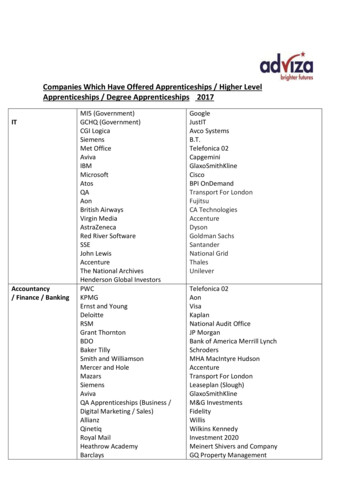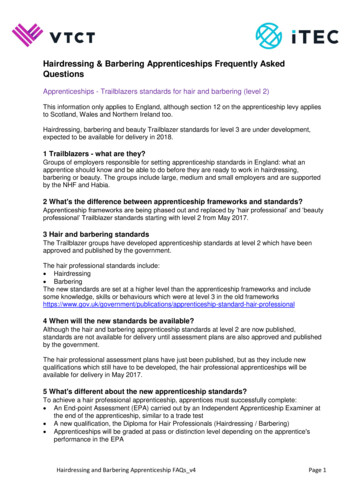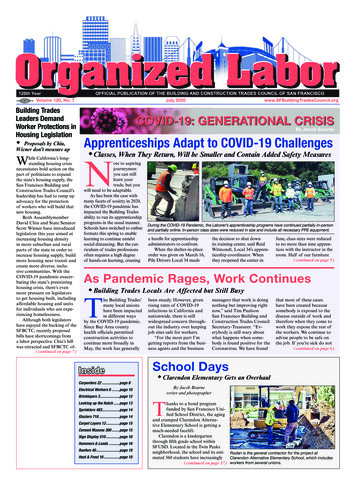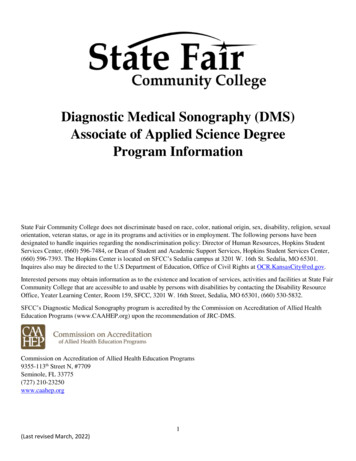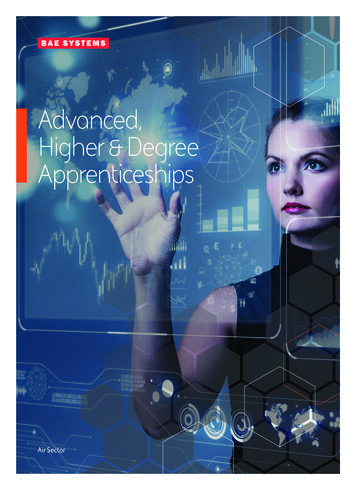
Transcription
Advanced,Higher & DegreeApprenticeshipsAir Sector
Contents:Advanced Business Administrator Apprenticeship Level 304Meet Kirsty05Supply Chain Practitioner Apprenticeship Level 306Your Journey07Advanced Engineering Craft Apprenticeship Level 308Meet Lucas09Advanced Engineering Technician Apprenticeship Level 310Meet Anna11Aircraft Maintenance Technician Apprenticeship Level 312Meet Keal13Aircraft Engineering Technician Apprenticeship Level 4142BAE Systems
Engineering Degree Apprentice Scheme in Software Level 615Meet Cara16Engineering Degree Apprentice Scheme in Aerospace Level 617Meet George18Finance Higher Apprenticeship Level 4/719Meet Marcia20Project Management Integrated Degree Apprenticeship Level 621Meet Aimee22Project Control Degree Programme Level 623Meet Jo24Notes25More Information27BAE Systems3
LEVEL3Advanced Business AdministratorApprenticeshipLocations: Warton and Samlesbury, BroughBackground:How much will I be rewarded?Are you that person who organises the tickets for the cinema, is neverlate to meet friends, likes to join in and meet new people or the one yourfamily ask for help with computers?Advanced Business Administrator apprentices typically start on a salaryof circa 12,500 per year, with increases throughout the scheme,dependent upon performance and behaviours. You will also gain accessto the Company pension and share saving schemes.Do you feel you can add real value to a business?If this sounds like you, then the Advanced Business AdministratorApprenticeship is the right role for you. This two-year scheme will offeryou the opportunity to gain real experience working in the businessareas which support all of our products. Through a combination of ‘offthe-job’ training, reviews and work placements, you will gain exposureto real challenges that support our business.The number and location of your placements will depend on the siteyou apply for.You will have the opportunity to learn how to: Deliver your responsibilities efficiently and with integrityWhere will I be working?Typically you will be placed within one business area for the duration ofyour apprenticeship. Business areas include: Business Development Commercial Manufacturing Operations Procurement Project Management Show a positive attitudeWhat are my future job prospects? Work well within a team Problem-solvingYou may be offered a permanent role in the business area you havesuccessfully completed the scheme in. There will also be opportunitiesto continue to develop these technical skills, knowledge andcompetence and to attend relevant training courses which supportyour development and the ever changing business needs. Develop your organisational skillsWhat support is available? Project management skillsYou will be supported throughout the apprenticeship in a number ofways. These include: To demonstrate strong communication skills (both written and verbal) Time managementDesignated Skills Coach/Early Careers team/Placement Manager/Business area Manager/Apprentice Peer Support Group/Apprenticescheme leadEntry Requirements:Length of Apprenticeship:Continual Development5 GCSEs A*-C or 9-4 (or equivalent)Including Mathematics and English.2 Years including Induction, OutwardBound (mandatory) and placementswithin your allocated area.The Advanced Business AdministratorApprenticeship will provide theopportunity to gain the following: Level 3 Business Administrator standard Level 2 Functional skills in Mathematicsand English (if not already achieved)In addition to this the BAE Systemsapprenticeship also incorporates othertraining such as; Business ImprovementTechniques and internal ProjectManagement training. Post successfulcompletion of your apprenticeship, thescope of the training available provides thepotential opportunity for furtherindividual development.4BAE Systems
Meet KirstySee what she had to say about our apprenticeshipsBackground:When I left school, I went on to work in anumber of roles within various businesssectors, from Sales roles to Customer Servicebefore my most recent role prior to joiningBAE Systems, which was working as a WardClerk for the NHS. When I initially thought ofapprenticeships, I imagined it being the typicalschool leaver route, meaning only School/College leavers could apply. However, afterspeaking to various friends and doing furtherresearch, it came to light that the schemesoffered at BAE Systems are not just open toSchool/College leavers but they are in factopen to all ages which is fantastic. This waswhen I decided now is the time to apply to kickstart my career with a great organisation.What is the best part of the job? And What would you say to peoplehow has this experience helped you thinking of applying?As an Apprentice you often get opportunity’sto develop and achieve?So far on my scheme, I have worked in threevery different Project Management Placementsall within the F-35 platform. I have workedin a cost tracking role in a project controlenvironment. I have worked in a Project/ Biddelivery role which gave me the opportunityto travel often to meet our customers. I amcurrently working in a Business Operationsrole within the Procurement and Supply chainfunction. My placements have all been variedand I have taken something different awayfrom each of them. The scheme has helpedme to develop a lot personally, I have gaineda confidence I didn’t know I had, I was scaredto present to anyone when I first started andnow I enjoy presenting. I have learned lots ofcomputer skills, especially around the Excelsoftware and Project Management software.The tutors and skills coaches have also helpedme to achieve great grades within myacademic studies.What has this experience led to?My experience so far within BAE Systemshas led me to meeting so many differentstakeholders and interesting people all aroundthe business. I have learnt so much not onlyabout the organisation but also projectmanagement and various functions withinthe business sector.to take part in extracurricular activities, Ihave also more recently become one ofthe editors for the Business ManagementApprentice Magazine the ‘BMA Buzz’ whichis a fun opportunity. I would definitelyrecommend applying for an apprenticeshipwith BAE Systems. You can decide to startan apprenticeship at any point in your career.Although I didn’t join BAE Systems straightfrom School or College, it was definitely thebest decision I ever made.Top tips for applying for theAdvanced Business AdministratorApprenticeship:Research the Company – what are its productsand services and who are their customersBe yourself!Include any previous work experience orvoluntary work and details of any interestingprojects you have worked on (e.g. organisingan event).BAE Systems5
LEVEL3Supply Chain PractitionerApprenticeshipLocation: SamlesburyBackground:How much will I be rewarded?Supply Chain (SC) is at the heart of every business – it is a system oforganisations, people, activities, information and resources involved inmoving products or services from supplier to customer.SCP Apprentices typically start on a salary of circa 12,500 per year, withincreases throughout the scheme, dependent upon performance andbehaviours. You will gain access to the Company pension andshare schemes.What does a Supply Chain Practitioner do?During your 24 months as an SCP Apprentice you will play a key rolein enabling BAE Systems to deliver on time, at the right cost and at theright quality. You will gain a broad knowledge of the supply chain andlearn the skills to contribute to our continuous improvement culture.SCP apprentices will utilise problem solving skills regularly to ensurecustomer demands are met.Alongside this you will complement your on the job learning withinteractive classroom sessions, taken by industry leading professionals,studying topics such as problem solving in the workplace, principlesof continuous improvement, responding to change and effectiveworkplace communication in our world class training facilities.As a result you will be best placed to use your learning to influence thedeveloping of technologies for future and existing products, taking BAESystems on the journey to factories of the future and supply chains.What are my future job prospects?There are many different roles available, including office-based Planningand Logistics for the Aircraft Maintenance and Aircraft ManufacturingFunctions and liaison between Customers and Suppliers in theProcurement Function. There are also global work opportunities at ourmany sites overseas, once you are qualified and have more experience.What support is available?You will be supported throughout the apprenticeship in a number ofways. These include:Designated Skills Coach/Early Careers team/Placement Manager/Apprentice Peer Support Group/Apprentice scheme leadEntry Requirements:Length of Apprenticeship:5 GCSEs A*-C or 9-4 (or equivalent)2 Years including Induction, OutwardBound (mandatory) and placementswithin your allocated area.Including Mathematics and English.ICT would be beneficial but isnot compulsory.6BAE SystemsWhat Qualificationswill I get?As an SCP Apprentice, you will not only becontinually developing your own skills andknowledge within the business, you willalso undertake part-time academic studywhich is fully funded by the company.Initially you will study towards a Level 3Supply Chain Practitioner qualification butthere is also a development framework inplace for those wishing to further extendtheir education and qualifications aftersuccessful completion of theapprenticeship.
YourJourneyPotential future qualificationsApprenticeship modules studies over 24 months* CILT (Chartered Institute of Logisticsand Transport) CIPS (Chartered Institute of Purchasingand Supply) APICS- Certified in Production andInventory Management (CPIM) Leadership in Supply Chain BSc at LeedsTrinity.Other benefits/ experiences World Class Training Facilities Competitive Salary and HolidayAllowance Work Life Balance Structured Career Development Global Opportunities.The FMCG Supply ChainEffective Workplace CommunicationDifferent Customer GroupsIdentifying and Managing RiskNew Products and Product CostingProcurementCapacity PlanningPlan ManufactureForecastingWorking with DataAnalysing DataResponding to ChangeIT Systems for the FMCG Supply ChainFlow Prioritisation Continuous ImprovementManagement Problem Solving Process Improvement in YourWorkplace Performance Improvement in YourWorkplace Developing Standard OperatingProcedures Completing Audit Documentation Logistics Problem Solving in Your Workplace.* Apprenticeship modules subject to change.BAE Systems7
LEVEL3Advanced Engineering CraftApprenticeshipLocations: Warton and SamlesburyBackground:How much will I be rewarded?Are you quite ‘hands on’ and enjoy making and repairing things? If sothen the Advanced Engineering Craft Apprenticeship might be for you.The apprenticeship will see you gain a strong grounding in engineeringpractice – using tools to carry out a range of tasks, operating safely inthe workplace and working on complex products for aircraft such as theF-35, Typhoon, Hawk & Tempest. You will spend the first year in full timetraining, learning core skills before moving into your trade discipline,such as Mechanical Fitter, Machinist and Electrician.Advanced Engineering Craft apprentices typically start on a salary ofcirca 12,500 per year, with increases throughout the scheme,dependent upon performance and behaviours. You will also gainaccess to the Company pension and share saving schemes.What does an Advanced Engineering CraftApprenticeship include?The apprenticeship will see you working on some of the world’s mostadvanced military aircraft.Year 1 of your training will be undertaken at the Academy for Skillsand Knowledge at Samlesbury, Lancashire, where you will be trainedin both practical and theory-based engineering. You will learn thebasics in electrical circuits, aircraft fitting, maintenance, toolmaking,mechatronics, machining, flight line awareness and ComputerAided Design.What are my future job prospects?There are many different roles available such as an electrician on a fastjet, an aircraft fitter on the latest unmanned air vehicle, or machiningcomponents for the F-35. There may be opportunities to work overseasfollowing completion of your apprenticeship.What support is available?You will be supported throughout the apprenticeship in a number ofways. These include:Designated Skills Coach/Early Careers team/Placement Manager/Apprentice Peer Support Group/Apprentice scheme leadAfter the first year, Craft apprentices as well as continuing academicstudies, will spend time on-site, learning and contributing to thebusiness, completing placements across our Warton and Samlesburysites in Lancashire.Entry Requirements:Length of Apprenticeship:5 GCSEs A*-C or 9-4 (or equivalent)Including Mathematics, Scienceand English.At least 48 months, including Induction,Outward Bound (mandatory). Year 1: Training undertaken atAcademy of Skills and Knowledge,Samlesbury. Year 2-4: Includes placements atWarton and Samlesbury in Lancashire.What qualificationswill I get?Craft apprentices study to attain a Level 3Apprenticeship Standard for Engineering.As well as classroom-based academicstudy, you’ll have practical trainingdelivered in our own fully equipped,in-house academy. Further training tosupport your apprenticeship takes placeduring your workshop based placements.You may apply to progress onto higherqualifications once you have completedyour apprenticeship, dependent on therequirements of the business at the time.8BAE Systems
Meet LucasSee what he had to say about our apprenticeshipsWhat apprenticeship areyou undertaking?number of different projects. In the first yearI undertook my basic training. This allowedme to develop and gain an understandingI undertook Level 3 NVQ extended diploma inof a range of engineering skills such as; CADAeronautical engineering specialising as a craft software training,3D printing, hands-on skillsapprentice fitter.such as fitting, electrical, turning, milling andworking on an aircraft. This was fantastic andDuring my apprenticeship, I undertook andgave me an idea which route I would like tocompleted my ONC and HNC in aeronauticalengineering attaining double distinction in both. follow whilst also building my confidence andgiving me an appreciation of all theseWhy did you want to do the training? different disciplines.Before undertaking my apprenticeship withBAE Systems, I worked as a level 3 qualifiedHGV mechanic for Lancaster city council.Although it was a fantastic job, I felt I hadreached the top of my game in that sectorand wanted to move on to my next challengein a company and sector that would allowme to grow and develop further to attain myeducational and professional ambitions.I have always been interested in how thingsworked and go together from a very youngage so pursuing a career in engineering wasthe obvious choice as the possibilities andscope of what you could be working with oron are endless. The most important aspectwhen thinking about work for me, is that youare interested, enjoy and are engaged by whatyou do, as that will always keep you driven andmoving forward in your chosen career.What placements have youundertaken and how have theseimproved your skills/knowledge?During my time at BAE Systems, I have worked atboth Warton and Samlesbury sites on aMy Third placement was on Hawk wing atSamlesbury; this was another great placementfrom a job complexity perspective they used agreat range of complex fitting skills which I'dnever come across before. I took part in the firstever T-45 Wing build at Samlesbury, previouslymanufactured at Brough.In the third year, I transitioned from structuresfitting to mechanical maintenance, systems, flightline and final assembly fitting. My forth placementwas in Typhoon development in 358 hanger.My first placement in the business was atWarton. I worked on the rear fuselage of Hawk; What would you say to peoplethis was a fantastic first placement to have due thinking of applying?to the complexity of the build and varied rangeThere have been so many different opportunitiesof skills needed during the build process. Theskilled people were very easy to get along with, to take part in at BAE Systems, I have won manyawards and have been involved in a number ofknowledgeable and helped me develop mycharitable and community projects alongsideskills. At the end of each placement, you havemy apprenticeship. I would tell anyone thinkingto deliver an end of placement presentation,of applying to go for it, as the experiencesthis builds confidence in public speakingavailable are fantastic.and presentation delivery. Whilst here I hadthe idea for a tool that would take time outTop tips for applying for theof production, improve the manufacturingprocess from a quality perspective and aidAdvanced Engineering Craftease of manufacture, I pursued this idea,Apprenticeship:for my college project, to the stage of getting itResearch the Company – what are its productsproduced and integrated into the build process.and services and who are their customers.My second placement was Samlesbury onBe yourself!F-35 VT fairings. This taught me how to adaptmyself and working style to accommodateInclude any previous hands on work experiencedifferent people, management styles andor voluntary work and details of any interestingaircraft builds. During my time here, theprojects you have worked on (e.g. overhaulingmanagement and supervision team were verya piece of machinery).helpful and passionate about giving myself andother apprentices exposure and experience toBAE Systems 9as much of the F-35 business as possible.
LEVEL3Advanced Engineering TechnicianApprenticeshipLocations: Warton and Samlesbury, BroughBackground:Do you like to know how things work? Do you have an inquisitivemind and like to break things down to see how they operate? If so,then our Advanced Engineering Technician Apprenticeship covers avast array of opportunities. In this four year apprenticeship you will begiven a strong grounding in practical and theoretical principles, as wellas the opportunity to gain practical skills and work experience in theengineering discipline.What does an Advanced Engineering TechnicianApprenticeship include?The apprenticeship will see you working on some of the world’smost advanced military aircraft. In the first year, you will undertakeyour training at either the Academy for Skills and Knowledge atSamlesbury Lancashire or the Advanced Maintenance Academy,Humberside, Lincolnshire. You will be trained in both practical andtheory-based engineering and in addition, learning the basics in suchthings as electrical circuits, aircraft fitting, fabrication, flight lineawareness, machining, carbon fibre and Computer Aided Design.Following the first year, North West based Technician apprenticeswill continue with academic studies and learning and contributing tothe business, by completing six placements. You will have theopportunity to gain experience in a variety of engineering areasincluding design, systems, in-service support and integration andworking alongside Industry experts. This allows Technicianapprentices to have worked on all stages of an aircraftlifecycle, giving them a well-rounded skill set and knowledge base.At Brough the apprentices rotate around several departments duringtheir second, third and fourth year of their apprenticeship, theseinclude Structures, Design, Aerodynamics, Structural and Dynamic test,Flight Systems and Technical Publications to mention a few.How much will I be rewarded?Advanced Engineering Technician apprentices typically start on a salaryof circa 12,500 per year, with increases throughout the scheme,dependent upon performance and behaviours. You will also gainaccess to the Company pension and share saving schemes. You willalso be encouraged to become accredited to a professional engineeringinstitution such as the Royal Aeronautical Society or Institute ofEngineering and Technology.What are my future job prospects?There are many different roles for an Engineering Technician; formerapprentices have gone on to be employed in roles such as FlightSystems Engineer, Mission Systems Engineer, System IntegrationEngineer and Support Engineer whether this be in the UK or overseas.What support is available?You will be supported throughout the apprenticeship in a number ofways. These include:Designated Skills Coach/Early Careers team/Placement Manager/Apprentice Peer Support Group/Apprentice scheme leadEntry Requirements:Length of Apprenticeship:5 GCSEs A*-C or 9-4 (or equivalent)Including Mathematics, Scienceand English.At least 48 months, including Induction,Outward Bound (mandatory).If you already hold a Level 3 or 90 UCAS Tarrif points in a BTEC EngineeringSubject or equivalent, please note youmay be transferred to a Level 4Engineering Technician apprenticeshipafter 12-18 months to aid your personaldevelopment. Please also considerapplying for the Level 6 EngineeringDegree Apprenticeship Schemes inAerospace or Software. Year 1: Training undertaken at Academyof Skills and Knowledge, Samlesbury.Brough Apprentices undertake theirtraining at the Humberside MaintenanceAcademy in Lincolnshire. Year 2-4: Includes placements atWarton and Samlesbury in Lancashire.Brough Apprentices, placementsare at Brough.What qualificationswill I get?Technician apprentices study to HNC levelin Aeronautical Engineering in additionto completing a Level 3 ApprenticeshipStandard for an Engineering Technician.As well as classroom-based academicstudy, you’ll have practical trainingdelivered in our own fully equipped,in-house academy. Further training tosupport your apprenticeship also takesplace during your work based placements.There is potential to gain membership to aregistered Engineering Institution.You may apply to progress to HNDlevel or Degree level engineeringqualifications once you have completedyour apprenticeship dependent on therequirements of the business at the time.10 BAE Systems
Meet AnnaSee what she had to say about our apprenticeshipsWhat apprenticeship areyou undertaking?Advanced Engineering TechnicianApprenticeship, which I have completed.I have also been studying the NVQ Level 3Engineering Technical Support (ExtendedDiploma), which I have also completed.I plan to carry on doing a Degree in theupcoming years but decided to take a gap yearinstead to fully learn my current job role.Why did you want to dothe training?For many years I have had a keen interestin engineering and have aspired to workwithin a technically advanced engineeringenvironment and believed that BAE Systemshad many diverse opportunities to fulfil thisaspiration. I personally enjoy the challenge ofsolving problems using a variety of analyticaltechniques. I liked the idea of being able togain hands-on experience within a majorengineering business which consists of somany roles and responsibilities, which wouldhelp me improve my engineering knowledgeand personal competencies. The trainingand placements which the apprenticeshippresented would help support my learningand development. I knew that I wantedto work within a company that had a vastrange of opportunities available to supportcareer progression and the BAE Systemsapprenticeship offered this.What placements have youundertaken and how have theseimproved your skills/knowledge?My first placement was within the Displaysand Controls Software team. Here I gained agood understanding of the coding languagethat was used on the Typhoon, as well asthe different computers that are used on theaircraft and how they interact with one another.I then moved onto Production andDevelopment Radar which was my firstplacement where I had physical interactionwith the aircraft. I gained an understanding ofhow the Radar works along with the sensorsthat are used and installed on the aircraft.I subsequently undertook a placement withinFlight Systems Support, where I gained anunderstanding of some of the systems on theaircraft, for example, the Life Support Systemand the Crew Escape System.I then moved onto a placement within 430Transition. This was my first placement thatwasn’t aircraft based but was more focusedon the facilities that produce the aircraft. Iwas responsible for supporting throughput ofproduction of the shop floor, ensuring that theworkers can work at the correct productionrate. This was achieved ordering appropriatemachinery and ensuring that the tools andequipment were available and ready for use.Following this, I went onto the shop floorfor my Craft placement, where I gained anunderstanding of the tools and productionprocesses that are used for the productionof the aircraft.Finally, I moved into a Typhoon Designplacement. This gave me an appreciation ofthe design software that is used for Typhoonand an understanding of the processes that areused to make design changes to thecurrent aircraft.What would you say to peoplethinking of applying?I would strongly recommend anyoneconsidering an Apprenticeship to apply. Ihave had so many opportunities availablesince I became a BAE Systems Engineeringapprentice. I was lucky enough to partake inthe Apprentice Innovation Challenge duringmy apprenticeship. This involved me managinga team to design, test and manufacture an ideathat was created by a local charity. This allowedme to develop a range of different skills, themain one being my confidence.Top tips for applying for theAdvanced Engineering TechnicianApprenticeship:Research the Company – what are its productsand services and who are their customers.Be yourself!Include any previous work experience orvoluntary work and details of any interestingprojects you have worked on (e.g. designing aproduct or overhauling a piece of machinery).BAE Systems11
LEVEL3Aircraft MaintenanceTechnician ApprenticeshipLocations: Aircraft Maintenance Academy - HumbersideBackground: M10 – Aviation LegislationAre you someone who is quite hands-on and enjoys making/ repairingthings or who likes to provide the support on 'how to'? If so then theAircraft Maintenance Technician Apprenticeship might be for you. Thisapprenticeship is designed to train the next generation of AircraftMaintenance Engineers. It provides a European Aviation Safety Agency(EASA) approved course. Year 1 is based at the Academy on HumbersideAirport where you will complete the EASA Category ‘A’ modulesincluding classroom time, workshop time and on-aircraft simulatedMaintenance tasks. Year 2 will be at either front line RAF Base orBAE Systems location in one of the following areas: M11 – Turbines, Structures and Systems Part 145 – Maintenance on ‘live’ aircraft including the fitting/removalof components (e.g. from a seal to engine), fault diagnosis and testingof systems (e.g. Radar or Flying Controls).Year 2 Part M – Supporting the maintenance including but not limited toResolving Engineering Problems, Fleet Planning, Scheduling Maintenanceand Work Packages, Technical Information Management. Diploma in Technical Services (or equivalent)What will I be learning?Aircraft Maintenance Technician apprentices for aircraft maintenancetypically start on a salary of circa 12,500 per year, with increasesthroughout the scheme, dependent upon performance and behaviours.You will also gain access to the Company pension and share saving schemes.This apprenticeship will train you to work in the aerospacemaintenance sector, covering:Year 1EASA Modules: M1 – Mathematics M2 – Physics M3 – Electrical Fundamentals M5 – Digital techniques M6 – Materials and Hardware M7 – Maintenance Practices M8 – Basic Aerodynamics M9 – Human Factors M15 – Gas Turbine Engines M17 – PropellersMilitary Specific Modules: AAES – Aircraft Assisted Emergency Systems Military legislation Military additions Diploma in Aircraft Maintenance (covering avionics/electrical andmechanical systems) or;How much will I be rewarded?What are my future job prospects?At the end of this apprenticeship, you will be eligible for a role maintainingaircraft within the business. However, dependent on performance andcapability, you may go onto undertake further training to Cat B licensedEngineer standard, Foundation Degree or even full Degree. This will enable youto take on more responsible roles such as Maintenance Supervisor/Manager.What support is available?You will be supported throughout the apprenticeship in a number ofways. These include:Designated Skills Coach/Early Careers team/Placement Manager/Apprentice scheme leadEntry Requirements:Length of Apprenticeship:5 GCSEs A*-C or 9-4 (or equivalent)including Mathematics, English andScience (preferable Physics).2 Years, including Induction and OutwardBound (mandatory). Year 1: residential training undertakenat RJ Mitchell Aircraft MaintenanceAcademy (AMA), Humberside Airport. Year 2: on the job training undertakenat a BAE Systems site or RAF Base.12 BAE SystemsWhat qualificationswill I get?You will achieve the EASA Cat Aapproved course with associated modulecertificates and during year 2 you willdevelop your on the job training with anNVQ / Diploma awarded by City and Guilds.You will also undertake other trainingsuch as team building which takes placeover a week at an Outward Bound Centrein the Lake District.
Meet KealSee what he had to say about our apprenticeshipsBackground:Before starting with BAE Systems, I was workingas a computer and network engineer for anumber of years before realising I needed achange. I’d always had an interest in engineeringand aviation, seeing many members of my familyenjoying careers in engineering roles. I havealways been encouraged to be hands-on so havebeen lucky enough to have project cars I haveworked on at the weekends (and when I find timestill dabble with them now), so the BAE Systemsapprenticeship was the ideal choice.What is the best part of the jobThe best part of the job is doing something Ilove
in a cost tracking role in a project control environment. I have worked in a Project/ Bid delivery role which gave me the opportunity to travel often to meet our customers. I am currently working in a Business Operations role within the Procurement and Supply chain function. My placements have all been varied and I have taken something .
